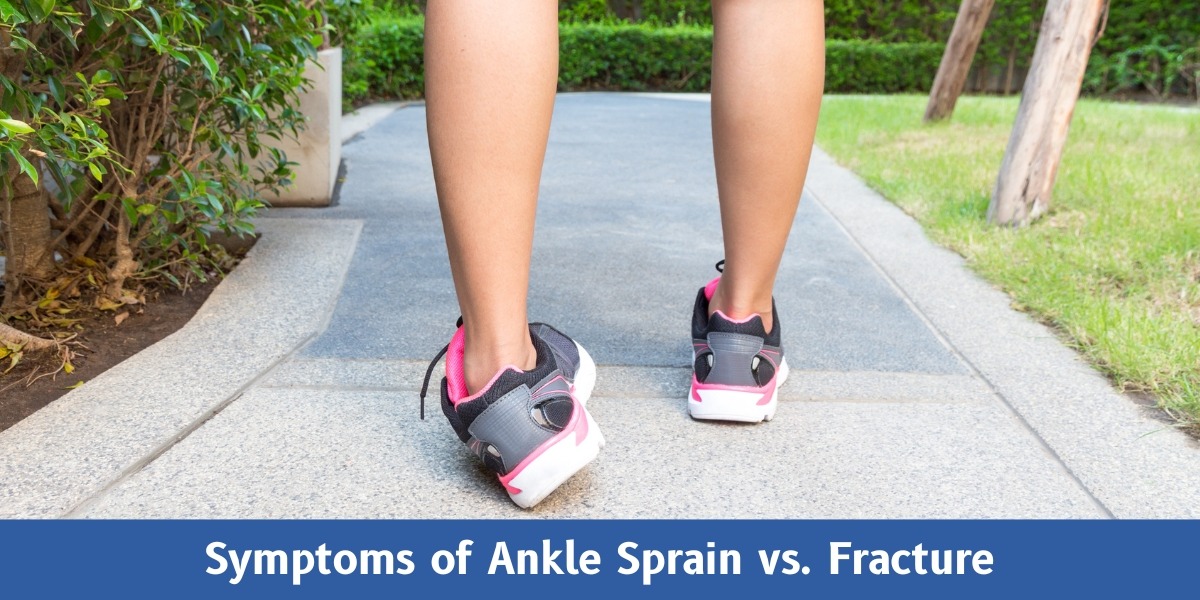Ankle injuries are common and can occur during various activities, from sports to simple missteps. Two prevalent types of ankle injuries are sprains and fractures. While both can cause significant discomfort and hinder mobility, understanding the differences in their symptoms is crucial for appropriate treatment and recovery. In this article, we will look into the symptoms of ankle sprains versus fractures, helping you to distinguish between the two and seek the right medical care.
Understanding Ankle Sprains
What is an Ankle Sprain?
An ankle sprain occurs when the ligaments that support the ankle are stretched or torn. Ligaments are tough bands of tissue that connect bones, providing stability to the joints. Sprains are classified into three grades based on their severity:
- Grade I: Mild stretching of the ligament with microscopic tears.
- Grade II: Partial tearing of the ligament.
- Grade III: Complete tear of the ligament.
Symptoms of Ankle Sprain
- Pain and Tenderness: Pain is often immediate and localized around the affected ligament. Tenderness may persist, especially when touching the area.
- Swelling: Swelling around the ankle joint is common and can develop quickly after the injury.
- Bruising: Bruising may appear around the ankle, indicating damage to the blood vessels.
- Limited Range of Motion: Movement in the ankle may be restricted due to pain and swelling.
- Instability: A feeling of instability or weakness in the ankle, particularly with more severe sprains.
- Popping Sensation: A popping or snapping sound may be heard at the time of injury, indicating a ligament tear.
Understanding Ankle Fractures
What is an Ankle Fracture?
An ankle fracture involves a break in one or more of the bones that make up the ankle joint: the tibia, fibula, or talus. Fractures can vary in complexity, from simple cracks to compound fractures where the bone pierces the skin.
Symptoms of Ankle Fracture
- Intense Pain: The pain from a fracture is usually severe and immediate, often described as sharp or throbbing.
- Swelling: Significant swelling occurs quickly after the injury, and may spread to the foot and lower leg.
- Bruising: Extensive bruising around the ankle, and sometimes the foot, is a common symptom.
- Deformity: The ankle may appear deformed or out of place, especially in the case of a displaced fracture.
- Inability to Bear Weight: Fractures typically make it impossible to bear weight on the affected foot.
- Bone Protrusion: In severe fractures, bone fragments may protrude through the skin, necessitating urgent medical attention.
Comparing Ankle Sprains and Fractures
Pain Levels
While both injuries cause pain, the intensity can differ. Ankle sprains often cause moderate pain that worsens with movement or pressure, whereas fractures result in severe, sharp pain that can be unbearable without medical intervention.
Swelling and Bruising
Both sprains and fractures can lead to swelling and bruising, but fractures typically cause more pronounced and widespread swelling. Bruising in fractures may also be more extensive due to the severity of the injury.
Mobility and Stability
Ankle sprains may allow some degree of movement, though painful, whereas fractures often lead to a complete inability to move or bear weight on the ankle. Instability is more common in severe sprains, while fractures cause structural deformity and immobility.
Deformity and Bone Protrusion
Visible deformity and bone protrusion are clear indicators of a fracture, not a sprain. If the ankle looks misshapen or bones are visible through the skin, it is almost certainly a fracture.
Diagnosing Ankle Injuries
Medical Examination
A healthcare professional will perform a physical examination, assessing pain points, swelling, and range of motion. They may also inquire about the circumstances of the injury to determine the likely cause and extent.
Imaging Tests
- X-rays: X-rays are the primary tool for diagnosing fractures. They provide a clear image of the bones and can reveal cracks or breaks.
- MRI and CT Scans: These advanced imaging techniques can offer detailed views of both bones and soft tissues, helping to diagnose ligament tears in sprains and more complex fractures.
Treatment Options
Treating Ankle Sprains
- Rest, Ice, Compression, Elevation (RICE): This method helps reduce swelling and pain in the initial stages.
- Immobilization: A brace or splint may be used to immobilize the ankle and allow the ligaments to heal.
- Physical Therapy: Rehabilitation exercises to restore strength, flexibility, and stability.
- Medications: Pain relievers and anti-inflammatory medications can help manage discomfort and swelling.
Treating Ankle Fractures
- Immobilization: Casts, splints, or braces are used to keep the bones in place during healing.
- Surgery: Severe fractures may require surgical intervention to realign and stabilize the bones using plates, screws, or rods.
- Physical Therapy: Post-recovery, physical therapy is essential to regain strength and mobility in the ankle.
- Pain Management: Medications to control pain and inflammation during the healing process.
Preventing Ankle Injuries
Strengthening Exercises
Regular exercises to strengthen the muscles around the ankle can enhance stability and prevent injuries.
Proper Footwear
Wearing supportive and appropriate footwear for different activities can reduce the risk of ankle sprains and fractures.
Warm-Up and Stretching
Proper warm-up and stretching before engaging in physical activities can prepare the muscles and ligaments, reducing the risk of injury.
Mindful Movement
Being cautious on uneven surfaces and using protective gear during sports can also prevent ankle injuries.
By understanding the differences between ankle sprains and fractures, you can better manage and treat these injuries. If you experience symptoms of either, it is crucial to seek medical attention promptly to ensure proper diagnosis and care. Consult Dr. Vinil Shinde at Chirayu Clinic, Call us at 77200 80890 or use our convenient online appointment request form. We are looking forward to helping you!

